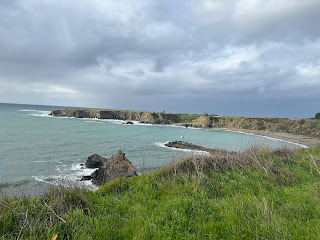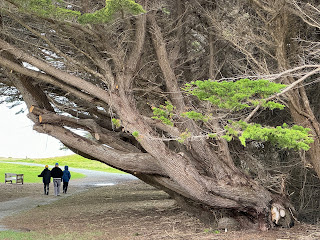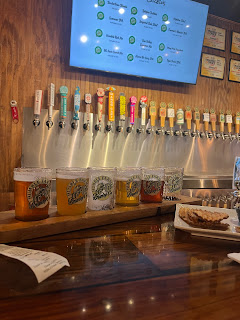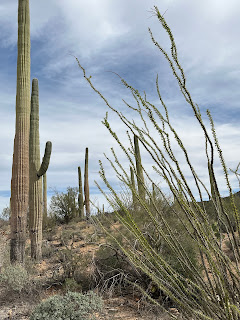quiet is the muse
Monday, March 18, 2024
Watching the horizon
Wednesday, March 6, 2024
and now the Pacific Ocean to our left
We feasted on local seafood, chowder and beer. The primo spot was Sea Pal! Located in the harbor under the Noyo Bridge the outdoor restaurant had a take out window and a wharf. There were a few picnic tables under a tent but the focal point was the large fire pit out on the wharf. We met a number of very interesting locals, at least 4 cool dogs and some fellow visitors - great conversations all around! Times like these reaffirm my faith in humanity.
Our second day back on the road was filled with sunshine and a much quieter ocean. We stopped in Newport for the day/overnight with a dear friend of Tim’s. As we always do, all three of us headed first for a walk along Nye Beach, one of the widest and prettiest beaches I have ever seen. Dinner, conversation, and a perfect sunset rounded out the day!
*
We are now headed to the Olympic Peninsula, specifically Olympic National Park. Looks like cold temps and rainy days lie ahead. Let’s see if Mother Nature is still with us.*
We are settled tonight in South Bend, WA overlooking the mudflats of Willapa Bay. No one else is here at the campground.
Monday, February 26, 2024
Wandering
Lake Merced, CA
*
We left Palm Springs, the desert and (most of) the freeways behind. There was a light rain as we snaked our way through the Morongo Valley to the eastern side of the San Bernardino Mountains and headed north into California’s Central Valley. As we crossed the Tehachape Mountains the rains abated and the landscape exploded in greens! Such a beautiful and welcoming sight.
Orange and lemon trees laden with fruit, nut trees in full blossom, busy farmlands and cattle ranches dotted the landscape for as far as you could see. We stopped in Edison, CA, just south of Bakersfield, at a favorite fruit stand to buy Cara Cara Oranges and Meyer Lemons…… California dreamin’!
I had plotted a “scenic” route north that would take us along the foothills of the Sierra Nevadas. At first we traveled on farm roads in between fruit groves; which meant drive for 3 miles, turn left, drive for 3 miles, turn right, repeat…….Luckily, by the time Tim mentioned that he thought we had probably seen enough orange trees we hit state road 49 and began our climb into the foothills.
*
Many mountain lakes are still in dire need of water.
Somewhere in the foothills of the Sierra Nevadas
*
After two days of wandering the hills we arrived in Davis, CA to visit friends. Davis is home to the University of California-Davis. It is a small city that truly feels like a town; quiet, walkable and surrounded by farms. The large student population makes the city vibrant and fosters many cultural attractions.

Saturday, February 17, 2024
From desert to desert
*
We left Organ Pipe National Monument on a cloudy morning with rain threatening and headed north on state route 85 passing through the towns of Why (why?) and Ajo, which was once known for its copper mines. We eventually hit I-8 and headed west. On the southern corner where Arizona meets California sits the Imperial Sand Dunes, the largest mass of sand dunes in CA. These windblown sands stretch for over 40 miles in a band averaging 5 miles wide and up to 300’ high. The area is a spot favored by off highway vehicle enthusiasts but there are also areas that cater more to wilderness and solitude seekers. The highway bisects the southern end of the dunes and they are quite spectacular to drive through.
We made our way into El Centro for the evening - located at the southern most part of California’s Imperial Valley and approximately 10 miles from the Mexican city of Mexicali. El Centro is the largest U.S. city to lie totally below sea level at -42 feet. Close to rail lines, highways, and the border, El Centro has relied mostly on the agricultural industry- we drove through lots of farmland seeing cauliflower, onions, and carrots! Once again, it was a perfect spot to grab some groceries, do a load of laundry, and find a brewery. Humble Farmer Brewing Co. stepped right up and filled the bill perfectly. In fact, their most popular beer is the 80 Acre Carrot Ale - brewed with local carrots. It was interesting to sample - the nose was a bit sweet with hints of cinnamon but the flavor was a proper heady ale. Homemade chips were the accompaniment and the local at the bar kept us entertained.
The following morning we drove north and then west on state route 78 into the Colorado Desert, the largest subdivision of the Sonoran Desert occupying 7 million acres. The Colorado Desert is known for its low elevations and extreme heat (similar to that of Death Valley). The area is vast, arid and flat.
*
We were staying in Palm Canyon at Anza-Borrego Desert State Park for 3 days. Located at sea level the park covers close to 600,000 acres and is the largest state park in CA. This desert park sits in a bowl surrounded by sculpted mountains - the Vallecito Mountains to the south and the Santa Rosa Mountains to the north. Only 2-3 inches of yearly rain falls in this valley because much of the precipitation is blocked by the mountains. There are more than 100 miles of hiking trails and 500 miles of dirt roads that spider web out into the far reaches of the desert.
We had a quiet stay; enough connectivity to watch the Super Bowl, mild temps encouraged a few good hikes, and some star gazing late in the evening. Could not ask for more……
I was sad to leave the desert landscapes that had become so familiar to me over the past 4 weeks. But it was time to move on. We exited the park heading northwest on State route 79 and climbed high over the park topping out somewhere around 4,500’. Much of the route follows the Pacific Crest Trail and is within the Cleveland National Forest. The desert gave way to Pinyon Pines, rolling hills, small farms and cattle ranches. It was quite idyllic and helped ease my desert separation anxiety. That lasted until we hit the reality of southern CA……..
THE FREEWAY!
We thought we had chosen a complete route without freeways but, alas, the 215 was suddenly in the mix. Ugh, I hate freeways - and the ever growing snake of cement mini malls that are forever being constructed along side them. It’s like you’re not allowed to take a breath.
*
We spent the night at Lake Perris Recreational Area, approximately 70 miles SE of Los Angeles. Luckily, the park was totally hidden from the highways and growing footprint of greater Los Angeles. Once again, it seemed as if we were alone, surrounded only by mountains. However, after nightfall we noticed the “glow” emanating from the other side of the mountains. The city was all around us - waiting.
*
We drove (all freeway) into Pasadena, CA and will spend 4 days here visiting friends. Then we’ll detour back south for 2 days to see friends in Palm Springs before heading north. It is always delightful to catch up with friends and even, when years have passed, we seem to, quite comfortably, step back into those old shoes and carry on the conversations as if they never ended.
Such is friendship.
*
I did get my quiet, desert fix. We visited the Huntington Library, Art Museum, and Botanical Gardens and spent the majority of our time there in the Desert Garden! Of course we also visited the Japanese, Palm, and Chinese Gardens as well as the Conservatory. The 130 acres of this magnificent institution, located in the heart of Pasadena, is a treasure. Not only are the gardens spectacular, the Library is one of the world’s great independent research libraries, and the Museums collection of European and American Art is outstanding.
I had not been back to the Huntington in over 35 years.
Thursday, February 8, 2024
Tuscon and the Sonoran Desert
We spent 9 days at Picacho Peak State Park, located approximately 25 miles west of Tuscon. The campground sits at the base of Picacho Peak which rises a stately 1,500’. The camp has just shy of 100 campsites - but because it is on a gentle slope it never feels like you are too close to other campers. The view down into the valley, the sight and sounds of trains in the distance, and the clear night sky (away from the lights of the city proper) make it an ideal spot. The campground has many hiking trails - some very challenging and others more scenic in nature. We tend to choose the scenic routes.
Since arriving in Arizona our weather has been glorious! Daytime temps in the low 70’s with nighttime dips into the high 40’s. Perfect.
Having an extended amount of time in one place has allowed us to fall into a rhythm - a day of outdoor or museum activities followed by a day of relaxing campside! No stress….. isn’t that what retirement is supposed to be?
When heading into Tuscon (or any larger town we are visiting) we try to combine that daily activity with fulfilling other normal life needs such as getting laundry done, doing groceries and, of course, searching out new breweries! Luck has it - we always find a good brewery.
It’s peak, covered in snow this time of year, Mount Lemmon, at 9,159’, is the highest point in the Santa Catalina Mountains. These mountains are part of the Coronado National Forest and are the southern most tip of the Rocky Mountain Range. The Catalina Highway , which begins on the northern outskirts of Tuscon, and climbs 6,000’ to Summerhaven, a ski resort near the top of Mount Lemmon, is one of the most scenic highways in the Southwest! The 27 miles of twists and turns begins with the low Sonoran topography of desert and climbs to the cool mountain forests of an Alpine zone. At every curve it seemed that we saw some new environment; at first saguaros and prickly pear filled the landscape, then stark rock formations and hoodoos, followed by towering pine and aspen, and then SNOW! All in 27 miles! Crazy.
The following day Summerhaven got an additional 5” of snow.
*
Saguaro are the largest cacti in the U.S. They grow very slowly at first…. maybe an inch a year during their first 8 years! It often takes up to 70 years for them to sprout branches (arms) and will reach full height between 40’-50’ when they are around 150 years old!! The Sonoran Desert creates a perfect habitat for saguaros - and the park is so densely filled that it is truly a forest of saguaros. It was stunning… arid, majestic, and, again, otherworldly.
In the park there are many trails to explore for all abilities and one dirt loop road.
*
Arizona-Sonora Desert Museum is a 21 acre botanical garden and zoo with over 2 miles of walking paths. Stunning gardens that showcase the ecosystem of the Sonoran Desert! A must see if you are ever in this region.
Just can’t get enough of sooooo many beautiful cactus!! And their flowers!
*
Leaving Tuscon we headed southwest on state route 15 thru the Tohono O’Odham Indian Reservation (People of the Desert). The Santa Rosa Valley, stretched out and quite barren, is sprinkled with very small communities (consisting of maybe a dozen homes or less…). Some of these communities have been abandoned and only the decaying houses are left.
Small roadside shrines (capillitas) seemed to line our route through the reservation. I must have counted at least 40 of them before I stopped counting. Some were quite elaborate and looked like mini cathedrals and others were quite simple. I did not want to stop and take pictures because I felt it would be intrusive. Also scattered along this road were small community graveyards - white wooden crosses festooned with plastic flowers and wreaths. I read that many of these graveyards, like the community they were part of, are abandoned. However, each year on the days of Dia De Los Muertos, family members still return to clean and decorate the graves.
*
Organ Pipe Cactus National Monument is located in southern Arizona and shares a border with the Mexican state of Sonora. Although common in Mexico, the park is the only place in the U.S where organ pipe cactus grow wild. 28 different cactus species live here in what are, for most of the year, extreme weather conditions. During the spring and summer temps can easily exceed 110 degrees with the ground temp often hitting 175! Currently it is quite windy with daytime temps around 58 degrees and nighttime lows around 38.
We will stay here for 4 days and then head into SoCal.































































